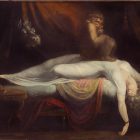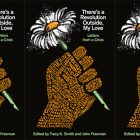Character & Setting; Figure & Background: A Painters Advice to Writers

The history and the evolution of background in painting follows very closely the development of setting in fiction. In the Pompeian style of ancient Roman mural painting, figures floated against solid backgrounds. The background provided no information about time or place or context. Similarly, early folk stories happened, “once upon a time,” in unnamed lands “far, far, away.” Stories weren’t localized or set in time.
By the 14th century painters began to bring the background into relationship with the figure but their efforts were largely aesthetic. Da Vinci’s Mona Lisa, for example, is set against a generic landscape. The scenery behind her gives us no insight into circumstance. Raphael, and other painters of the High Renaissance, with their draperies and ornamental backdrops, handled background similarly. For a long time, literature followed suit depicting setting solely for it’s sentimental beauty and pictorial value.
It wasn’t until fairly recently that both painting and literature began to fully exploit the relationship between character and setting and figure and ground.
An early example of this change in literature is evident in Daniel Defoe’s use of setting in Robinson Crusoe. Here Defoe puts the Crusoe’s island to work almost exclusively to determine action of the story.
For painters, the earlier Pompeian technique of filling in the background became just a starting point. Throwing a wash of color over a blank canvas is the first thing painters are taught to do. And from there the relationship of foreground and background begins.
Does the background highlight the subject, or does it make the subject recede? How does the subject relate to the objects around it? What are those objects and how do they elucidate the figure? What is the context? How does the color, the light, the tone, the quality of line in the scene change how the viewer sees things. How do all these elements work together and make the viewer feel?
Character and setting, figure and background. In literature and in art, they should work together to bring a concise picture into view.
Consider how the writer Robert Hichens handles setting in first paragraph of The Green Carnation written in 1894:
He slipped a green carnation into his evening coat, fixed it in its place with a pin, and looked at himself in the glass, the long glass that stood near the window of his London bedroom. The summer evening was so bright that he could see his double clearly, even though it was just upon seven o’clock. There he stood in his favourite and most characteristic attitude, with his left knee slightly bent, and his arms hanging at his sides, gazing, as a woman gazes at herself before she starts for a party. The low and continuous murmur of Piccadilly, like the murmur of a flowing tide on a smooth beach, stole to his ears monotonously, and inclined him insensibly to a certain thoughtfulness. Floating through the curtained window the soft lemon light sparkled on the silver backs of the brushes that lay on the toilet-table, on the dressing-gown of spun silk that hung from a hook behind the door, on the great mass of gloire de Dijon roses, that dreamed in an ivory-white bowl set on the writing-table of ruddy-brown wood….He frankly admired himself as he watched his reflection, occasionally changing his pose, presenting himself to himself, now full face, now three-quarters face, leaning backward or forward, advancing one foot in its silk stocking and shining shoe, assuming a variety of interesting expressions.
Hichens paints the figure in full relationship to his background. His character is defined by his setting and the setting defines him. The soft lemon light floating through the curtained window suggests an overwrought charm. His character’s emotional well-being is conveyed by the convivial arrangements of objects around him: the silver brushes on the toilet-table, the silk dressing-gown on the hook behind the door, the roses in the ivory-white bowl. And the depth of his vanity is rendered by what those objects are, and of course, the mirror.
Setting can be used to help define personality. It can coexist in emotional harmony with the subject, as it does here. Or it can create tension by doing the opposite.
If your aim is to project loneliness, try doing it in conjunction with setting. For example, by placing your character in the center of a large empty backdrop—a street or field. Or, do the opposite and place her alone in the middle of a crowded street. If self-absorption and cluelessness are what you’re after, try contrasting your character’s sunny disposition and healthy pallor with objects and symbols of deprivation and darkness.
With a purposeful and carefully drawn interplay between setting and character, there is almost nothing a writer cannot do.



